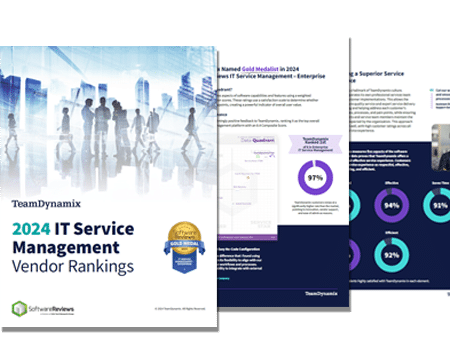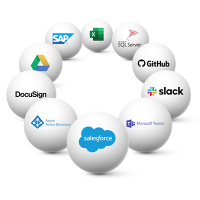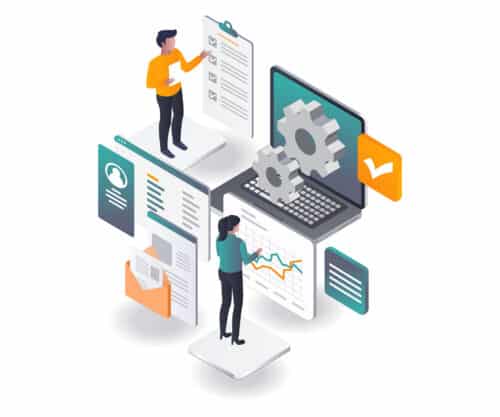
Enterprise Service Management: Why a Unified Platform Matters
Enterprise Service Management (ESM) is the practice of extending IT Service Management (ITSM) principles beyond the IT department to other areas of an organization. ESM

The Info-Tech ranking report offers a unique view of the market based entirely on in-depth customer interviews. Download the Info-Tech ITSM Quadrant and Customer Viewpoint report today.

We’ll show you some of our best situations and show you exactly how to execute them to get immediate results. The best part is, iPaaS tools often feature easy-to-use click and drag functionality, meaning you don’t need a dedicated employee building integrations and workflows.

System Integrators, Value Added Resellers, Technology Providers, and Buying Consortiums can benefit from a partnership with TeamDynamix.

The Info-Tech ranking report offers a unique view of the market based entirely on in-depth customer interviews. Download the Info-Tech ITSM Quadrant and Customer Viewpoint report to gain a better understanding of key vendor strengths and emerging market requirements.
In today’s modern IT environment, Enterprise Service Management (ESM) has become a go-to tool for IT leaders who want to increase efficiency and reduce costs organization-wide. But what exactly is ESM? And how can it benefit your organization? Let’s take a look at five of the top benefits of ESM.
Before we get to the benefits, let’s define Enterprise Service Management. ESM is a comprehensive approach to the delivery of services that helps enterprises achieve their goals and objectives. It focuses on streamlining service delivery, reducing costs, improving customer satisfaction and helping the enterprise become more agile. It is based on a combination of IT Service Management (ITSM) best practices, such as ITIL, and an advanced set of tools and capabilities to support these activities.
In other words, when you use ITSM processes and tools outside of IT to improve service management and delivery – that’s ESM.
From managing requests to improving information flow, every department struggles with email inquiries, status spreadsheets and failed attempts at creating order for project and request intake. And with ESM, these requests can come in all shapes and sizes: from benefit changes in HR to work orders in facilities, event support and creative services in marketing, equipment reservations, security passes, parking permits, etc.
With ESM you can take your ITSM tool and tailor portals for each department, automate routing and workflows, and track and report on outcomes. Other befits of an ESM approach for service management and delivery include:
As you can see, Enterprise Service Management offers many benefits for organizations looking to stay ahead in today’s fast-paced digital world—from improved process efficiency to cost savings associated with automation and streamlined access control measures designed to keep data secure yet accessible when necessary. All these factors combine to make ESM an essential tool for IT leaders who are looking for ways to maximize their return on investment on their technological investments while keeping services running smoothly at all times.
Casino Arizona and Talking Stick Resort have improved their ESM capabilities with the help of TeamDynamix’s ESM platform.
Independently owned and operated by the Salt River Pima-Maricopa Indian Community in Scottsdale, Arizona, these casino and resort properties employ about 3,500 people altogether.
In looking for a new ESM platform, Casino Arizona and Talking Stick Resort wanted the ability to configure the system easily and make changes flexibly and dynamically. “We looked at a number of systems,” Adam Dunn, program manager, said. “In TeamDynamix, we found the one that was most user-friendly.”
With its “low-code, no-code” design, TeamDynamix is highly configurable, allowing organizations to create personalized service categories (both simple and complex) and build customized workflows for managing multistep processes.
In addition, the platform’s enterprise Integration and automation capabilities allow IT staff to create customized integrations between TeamDynamix and other software programs using a simple, drag-and-drop flow builder. As a result, TeamDynamix customers can build workflows for automating almost any service function to fit their needs.
Finally, because TeamDynamix is easy to use and configure, it lends itself nicely to ESM and can be easily adopted by departments outside of IT.
Phase one of the properties’ implementation of TeamDynamix has involved the IT and AV departments. Phase two includes housekeeping and security.
In housekeeping, for example, one of the areas the tool will be used to help with is resource capacity planning around events.
“We have an event space where we host a variety of different things,” Dunn said. “We’ll be using the tool to get out in front of these and schedule housekeeping for room cleanings before and after these events. All of these housekeeping requests can be scheduled and managed through a ticket. This allows our housekeeping department to see what events are upcoming that they need to plan for and staff appropriately. And if we have a performer coming into our nightclubs, a lot of times housekeeping is tasked with clearing space, so they can see when those requests come in and make sure the right resources are available.”
With TeamDynamix, users can easily track the status of requests from the convenience of their phone and resend a request as needed. The system also can be configured to resend a request automatically after a certain amount of time has passed without a response.
“Being able to see requests in real-time and resend notifications as needed has been a huge asset to our department,” IT Support Manager Jonathan Vorndran said. “It helps move the approval process along faster.”
“I would say we averaged four or five days to obtain proper approvals with our previous system,” Dunn added. “Now, we’re looking at one or two days. We’re talking about a 70-percent decrease. If you need access to an application, waiting four days for all the approvals to take place and get you into the system keeps you from being able to do your job. Getting that down to just a day or two has been critical for us.”
Can your organization benefit from an organization-wide approach to service management? Learn more about ITSM, ESM and smart service management in our latest eBook: Smart Service Management – Working Better Together With a Connected Enterprise.

Enterprise Service Management (ESM) is the practice of extending IT Service Management (ITSM) principles beyond the IT department to other areas of an organization. ESM

As businesses grow, so does the complexity of managing their services. This is where Enterprise Service Management (ESM) comes in, offering a structured approach to

As IT departments modernize their service management tech stacks, automation stands out as a pivotal force driving significant transformations in how the IT service desk
TeamDynamix’s award-winning SaaS cloud solution offers IT Service and Project Management together on one platform with enterprise integration and automation.
[email protected]
(877) 752-6196
Contact Us
